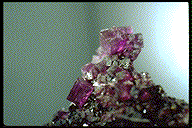

- Chemistry: NaCaAlF6 - H2O, Hydrated Sodium Calcium Aluminum Fluoride.
- Class: Halides
- Uses: As mineral specimens.
Specimens
Thomsenolite forms from the alteration of cryolite, another unusual halide mineral which by no small chance is associated with thomsenolite. Thomsenolite also is found with the mineral pachnolite which has the same chemistry as Thomsenolite but has a slightly different structure. The better cleavage and softness of thomsenolite and its more obvious monoclinic crystal habit serve to distinguish it from pachnolite. Both minerals are found as druses lining the pockets of the very unique pegmatitic rocks at Ivigtut, Greenland.
PHYSICAL CHARACTERISTICS:
- Color is colorless or white.
- Luster is vitreous.
- Transparency: Crystals are transparent to translucent.
- Crystal System: Monoclinic.
- Crystal Habits include druses of prismatic crystals with a distinctly monoclinic slant. Also pseudo-cubic crystals are common.
- Cleavage is perfect.
- Fracture is conchoidal.
- Hardness is 2
- Specific Gravity is 2.9 (average).
- Streak is white.
- Associated Minerals include
pachnolite,
cryolite,
ralstonite and limonite. - Notable Occurrences are limited to Ivigtut, Greenland and other southwestern Greenland localities.
- Best Field Indicators are crystal habit, softness, associations, locality and good cleavage.





